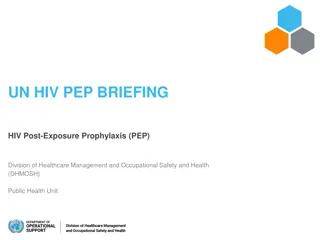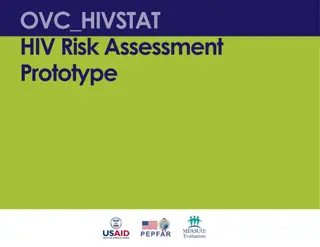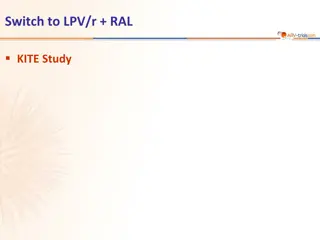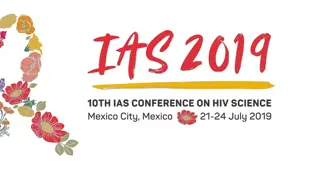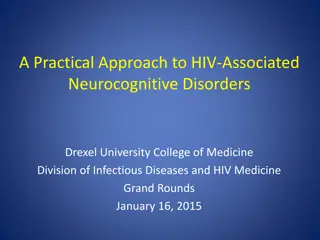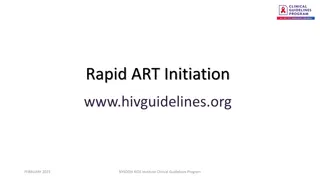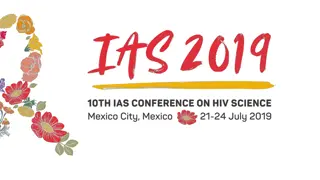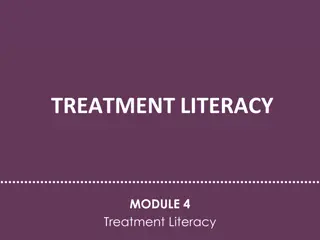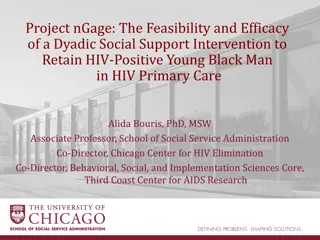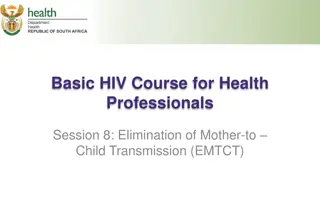Virological Success Assessment in Primary HIV Infection Treatment at 24 Weeks
Assessing virological success in primary HIV infection treatment at 24 weeks is pivotal for predicting outcomes and determining the relevance of this timeframe as an endpoint. This study evaluates a cohort of patients with primary HIV infection to identify predictive factors of virological failure at week 24, emphasizing the importance of timely intervention and monitoring in early antiretroviral therapy. Demographic characteristics of the patient population are also outlined to provide a comprehensive overview.
Download Presentation

Please find below an Image/Link to download the presentation.
The content on the website is provided AS IS for your information and personal use only. It may not be sold, licensed, or shared on other websites without obtaining consent from the author.If you encounter any issues during the download, it is possible that the publisher has removed the file from their server.
You are allowed to download the files provided on this website for personal or commercial use, subject to the condition that they are used lawfully. All files are the property of their respective owners.
The content on the website is provided AS IS for your information and personal use only. It may not be sold, licensed, or shared on other websites without obtaining consent from the author.
E N D
Presentation Transcript
Is twenty-four weeks too short to assess virological success in primary HIV infection treatment ? Anne Vandendriessche1, Thomas Mourez2, V ronique Lem e2, Yasmine Debab1, Gilles Peytavin3, Jo l Ladner4, Fran ois Caron1, Jean-Christophe Plantier2, J r mie Leporrier1 1 Infectious Diseases Department, Rouen University Hospital, France 2 Virology Unit, Rouen University Hospital, France 3 Pharmacology and toxicology laboratory, Bichat-Claude Bernard hospital, APHP Paris, France 4 Epidemiology and Public Health Department, Rouen University Hospital, France 8th IAS Conference on HIV Pathogenesis, Treatment and Prevention, Vancouver, July 2015
Disclosure No conflict of interest to report
Background ART in primary HIV-1 infection (PHI) No randomized clinical trial Individual and collective benefits1-2 French3, European4 and US guidelines5: treat all PHI Recommended ART in PHI3-5 Analogy with established infection Commonly, TDF/FTC + 3rdagent (protease inhibitor) Goal of ART: virological success Undetectable pVL at week 24 of treatment (W24) 1 Le T. et al. NEJM 2013;368(3):218-30. 2 Cohen MS. et al. NEJM 2011;365(6):493-505. 3 French Guidelines. Rapport Morlat 2013. 4 European AIDS Clinical Society Guidelines, Version 7,1, 2014. 5 Huldrych F. et al. JAMA 2014;312(4):410-425.
Objectives Analyze a cohort of patients with PHI: Predictive factors of virological failure at W24 ? Is the W24 end-point relevant for assess virological response ?
Methods Rouen University Hospital 2003-2013 Patients with PHI Positive p24 Ag with compatible Western-Blot Incomplete and compatible Western-Blot Positive plasma viral load with negative serology in the previous 3 months Early ARV 3 months after diagnosis Evaluation at W24 Failure Success (pVL < 40 copies/mL) (pVL 40 copies/mL) Genotypic resistance test W24 versus baseline ART plasma dosage Stop
Demographic characteristics - 55 patients Mean age (SD) 36 (12) years Min Max 16 - 67 Gender Male / Female 48 / 7 Sex-ratio 6.6 Ethnicity - White (%) 50 (91) - African (%) 5 (9) Source of contamination - MSM (%) 36 (65) - Heterosexual (%) 17 (31) - Unknown (%) 2 (4)
Baseline immuno-virological characteristics Baseline CD4 count Mean SD 479 252 / mm3 30 25 Number of patients 44% 20 Baseline plasma viral load Mean SD 15 10 20% 20% 2.4 3.4 x 106 copies / mL 16% 5 25 0 20 < 200 200 - 350 350 - 500 > 500 Number of patients 36% 31% 15 22% 10 5 9% 0 106-107 >107 104 -105 105-106 104
ART regimen 2 NRTI + 1 PI 43 (78%) Mean time between virological diagnosis of PHI and ART initiation = 11 12 days. TDF - FTC - LPV/r 14 AZT - 3TC - LPV/r 13 TDF - FTC - DRV/r 12 TDF - FTC - ATZ/r 3 AZT - DDI - LPV/r 1 2 NRTI + 1 NNRTI 6 (11%) 11 different combinations : Mostly TDF/FTC: 69% (n=38) Protease inhibitor as 3rdagent: 89% (n=49) AZT - 3TC - NVP 2 TDF - FTC - EFV 2 AZT - 3TC - RFV 1 TDF - FTC - RPV 1 4-5 drugs therapy 6 (11%) TDF - FTC - LPV/r - RAL 3 TDF - FTC - DRV/r - RAL - MRV 3
Plasma viral load at W24 50 45 80% 40 35 Virological failure 11/55 patients (20%) Mean pVL : 155 copies / mL Min: 45 - Max: 391 30 Number of patients 25 20 15 10 5 0 pVL (cp/mL) < 40 40 - 100 100 - 200 200 - 300 300 - 400 ART plasma concentrations within the expected range: 9/11 (82%) Resistance selection at W24: 0/11
ART and virological failure at W24 2 NRTI + 1 PI 9/41 (21%) 16 14 Number of patients 12 10 2 NRTI + 1 NNRTI 1/6 4-5 drug therapy 1/6 8 6 4 2 0 TDF - FTC - LPV/r AZT - FTC - LPV/r TDF - FTC - DRV/r TDF - FTC - ATV/r AZT - DDI - LPV/r AZT - 3TC - NVP TDF - FTC - EFV TDF - FTC - RPV AZT - 3TC - EFV TDF - FTC - LPV/r - RAL TDF - FTC - DRV/r - RAL - MRV "Virological success" "Virological failure"
Predictive factors of virological failure at W24 Univariate analysis: Virological failure not associated with: Age, gender, ethnicity Source of contamination ART regimen Virological failure associated with: Baseline pVL and CD4 count Virological success Virological failure Univariate analysis 1.9 x 106 (SD = 3 x 106) 4.3 x 106 (SD = 4.4 x 106) Mean baseline plasma viral load (copies/ml) p = 0.03 Mean baseline CD4 count (/mm3) 510 351 p = 0.04 (SD = 242) (SD = 258) Multivariate analysis: no predictive factor
Plasma viral load after W24 60 54/55 98% 52/55 96% 51/55 93% 44/55 80% 50 Number of patients 40 Patients with pVL < 40 copies/mL 30 W24 W48 W72 W96 Number of patients with pVL > 40 copies/mL 20 11 4 3 1 Mean pVL Min - Max 155 108 169 110 10 45 - 391 55 - 174 85 - 222 0 J0 W24 W48 W72 W96
Conclusion Causes of pVL > 40 copies/mL at W24: Not: ART resistance No resistance selection between baseline and W24 in patients with virological failure Partial: Subtherapeutic ART concentration 2/11 patients In univariate analysis: High baseline viral load pVL > 40 copies/mL at W24: not a virological failure W24 end-point: to short to assess virological success
Acknowledgments All co authors Infectious Diseases Department: Dr Gueit, Dr Debab, Dr Etienne, Dr Delbos, Dr Chapuzet Virology Unit: all the technicians Mrs Sabourin COREVIH Haute- Normandie University of Rouen




